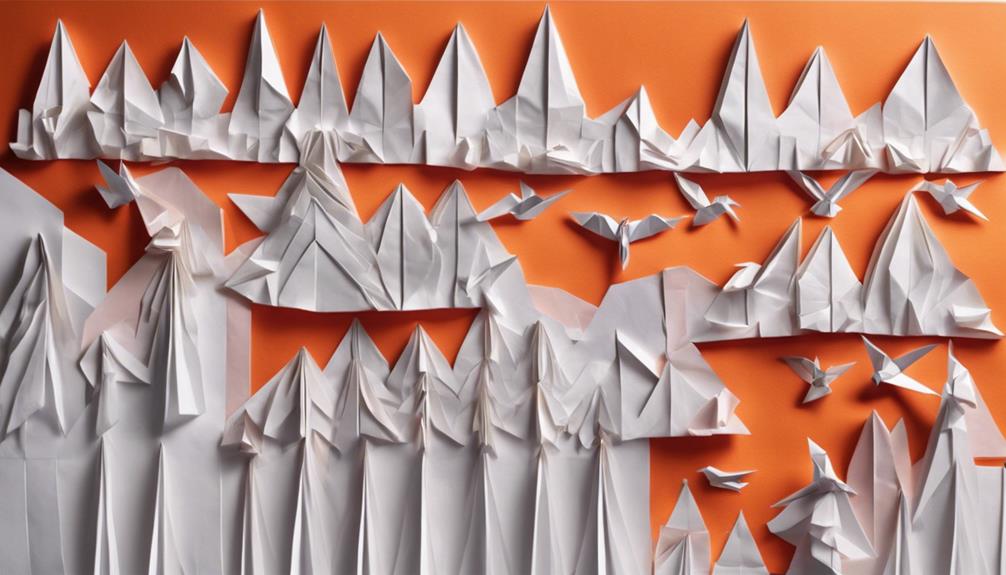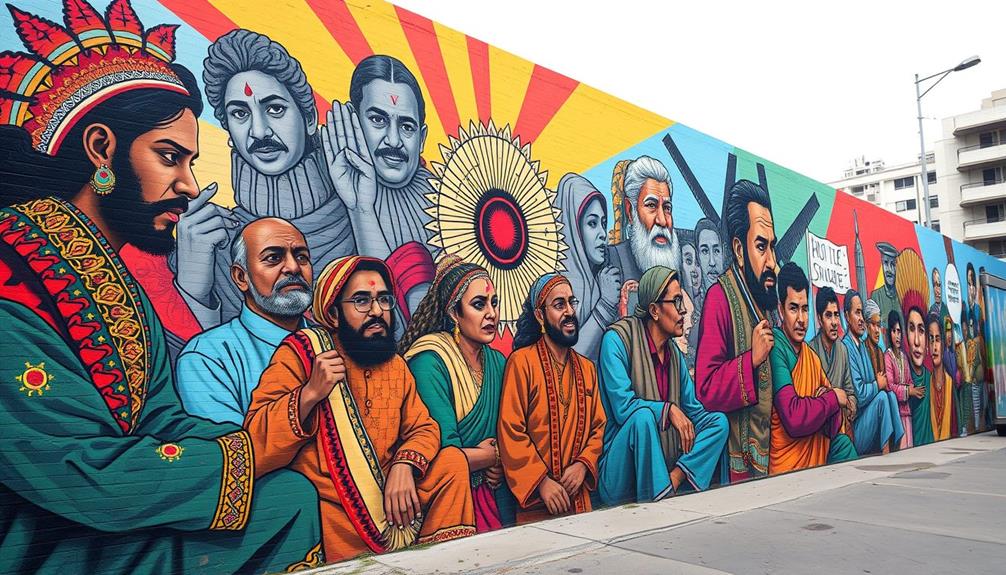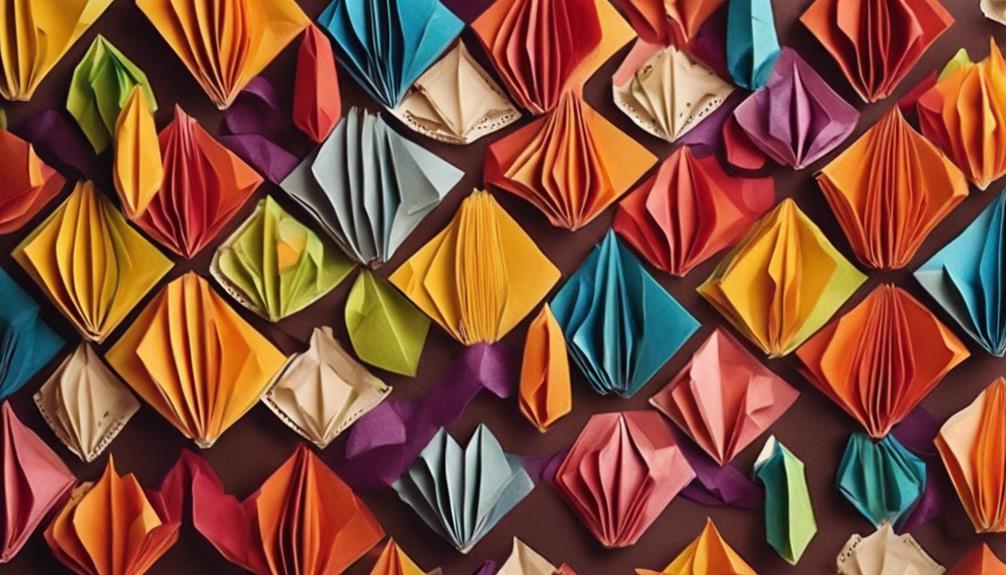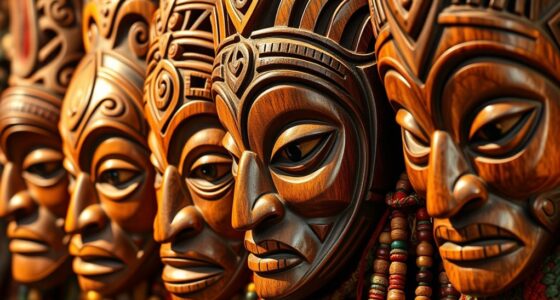Kalighat art, emerging near Kolkata's Kalighat temple in the 19th century, combines Hindu themes with modern social commentary, evolving from religious symbolism to socio-political messages. This art form reflects a unique blend of traditional techniques and contemporary influences, portraying societal changes and issues. Themes range from Hindu deities to everyday life scenes, offering insights into colonialism, gender roles, and urban dynamics. Influencing artists globally, this tradition continues to shape Indian art and culture, impacting movements like the Bengal School of Art. Its preservation in rural West Bengal districts and through contemporary artists highlights its enduring relevance and evolution.
Key Takeaways
- Originated near Kalighat temple in Kolkata in 19th century.
- Evolution from religious narratives to socio-political reflections.
- Influenced modern artists like Jamini Roy and Bengal School.
- Depicts Hindu deities, societal changes, and everyday life scenes.
- Continues to shape Indian art, culture, and global artistic expressions.
Origin and Evolution
Originating near the Kalighat temple in Kolkata, Bengal in the 19th century, Kalighat art initially served as souvenirs for temple visitors. Indian artists crafted these paintings, blending traditional themes of Hindu gods with contemporary scenes of urban life. The collection of Kalighat paintings evolved from religious narratives to encompass a wide array of subjects, reflecting the changing socio-political landscape of India.
Initially rooted in depicting mythological tales, these artworks transformed to portray everyday life, social issues, and political commentary. The narrative style of Kalighat art captured the essence of modern moral principles and values, interwoven with sentiments against the British Raj and orthodox beliefs.
Over time, the traditional techniques of Kalighat art merged with contemporary influences, creating a unique fusion of styles that both honored the past and embraced the present. This evolution marked a significant shift in the art world, democratizing the portrayal of social issues and cultural practices through vibrant colors and bold lines.
Themes and Subjects

A diverse array of themes and subjects are depicted in Kalighat paintings, ranging from Hindu deities and mythological stories to societal changes and everyday life scenes. These paintings not only showcase religious motifs such as depictions of Hindu deities like Hanuman, Ganesha, and Durga engaged in epic battles but also explore societal transformations, incorporating elements of British colonialism and contemporary events.
Kalighat artists skillfully weave societal satire, proverbs, and reflections on social issues into their artwork, offering a unique blend of social commentary and artistic expression. Mythological stories from the Mahabharata and Ramayana find their place alongside scenes portraying everyday life, animals, social reflections, and critiques of social evils.
Through this multifaceted approach, Kalighat paintings serve as a mirror reflecting the complexities of the society they emerged from, capturing both the essence of traditional beliefs and the evolving nature of societal dynamics.
Cultural Significance

The cultural significance of Kalighat art lies in its ability to serve as a dynamic reflection of evolving social norms and cultural dynamics in 19th-century Bengal. Indian artists of the time utilized this traditional art form to depict a wide range of themes, from religious deities to everyday life in the colonial capital.
The collection of Kalighat paintings provides a valuable insight into the societal issues that were prevalent during that era, including commentary on colonialism, gender roles, and societal changes within the Hindu community. By capturing the essence of urban life and social transformations, these artworks have become a significant part of Indian cultural heritage.
Today, many of these paintings can be found in museums, showcasing the artists' engagement with and critique of the cultural and political landscape of their time. Through their depictions, Kalighat artists have left a lasting legacy that continues to be valued for its historical and cultural significance.
Influence and Legacy

Kalighat paintings have left a lasting impact on the world of art, shaping the influences and legacies of subsequent artists and movements. This popular art form has influenced modern artists like Jamini Roy and the Bengal School of Art, showcasing its enduring legacy in Indian art and culture.
The living tradition of Kalighat art continues to inspire contemporary artists globally with its unique style and thematic richness. The global inspiration drawn from Kalighat paintings has even transcended borders, influencing art movements in France and engaging renowned artists like Pablo Picasso.
The protomodern tradition of Kalighat art hasn't only preserved its legacy but also paved the way for a diverse range of artistic expressions, making it a significant cultural phenomenon that resonates with audiences worldwide.
Preservation and Recognition

Preserving and recognizing the rich heritage of Kalighat art is essential in ensuring its continued relevance and appreciation in the modern art world. Despite facing a decline in the early 20th century due to commercial pressures and shifting artist interests, the tradition perseveres in rural districts of West Bengal such as Medinipur and Birbhum.
Contemporary artists, like Anwar Chitrakar, play an important role in keeping the tradition alive by producing modern Kalighat paintings that focus on secular themes, current events, and mixed religious depictions. These artistic expressions not only showcase the evolution of the art form but also highlight its enduring impact on Indian art history.
Additionally, the influence of Kalighat paintings can be seen in various artistic expressions and is prominently displayed in museums and private collections, solidifying its place in the cultural landscape and emphasizing the need for continued preservation and recognition of this unique artistic tradition.
Frequently Asked Questions
What Is the Significance of Kalighat Painting?
Kalighat painting carries significant cultural value because of its evolution from religious depictions to addressing modern moral and societal issues.
The art form's vibrant colors, bold brush strokes, and symmetrical curves not only visually captivate but also convey powerful messages.
This shift in themes and styles has influenced contemporary Indian art, preserving traditional roots while reflecting evolving perspectives on ethics, society, and politics.
Which Is the Most Famous Kalighat Painting?
The most famous Kalighat painting is 'The Babu and Bibi,' a renowned depiction of a Bengali gentleman and lady symbolizing societal dynamics. This iconic artwork showcases wit, humor, and social commentary typical of Kalighat paintings, capturing the essence of urban life in colonial Bengal.
Through the portrayal of Babu and Bibi figures, the painting offers insights into evolving roles and perceptions in 19th-century Bengali society, serving journalistic purposes by reflecting societal norms and dynamics of the time.
How Can I Identify Kalighat Painting?
To identify a Kalighat painting, look for bold brushwork, vibrant colors, and simplified forms.
Pay attention to emotional facial expressions, dynamic compositions, and a mix of religious, mythological, secular, and social themes.
Notice strong outlines, quick brush strokes, and a fusion of traditional and Western influences.
Focus on bright colors, intricate details, and diverse subject matter.
These characteristics collectively define the unique style of Kalighat art.
What Was the Decline of Kalighat Painting?
The decline of Kalighat painting in the early 20th century resulted from commercial demands and the influx of inexpensive printed copies. As a consequence, many Kalighat patua families relocated from Kolkata to rural regions or sought other employment opportunities. This shift marked a departure from the traditional Kalighat style, influencing a change in artistic practices.
Despite these developments, Kalighat painting persists in rural West Bengal, with artists in areas like Medinipur and Birbhum continuing the legacy by exploring secular subjects and contemporary themes.
Conclusion
To sum up, Kalighat art is a protomodern tradition originating in Kolkata, India. It offers a unique glimpse into the cultural and artistic heritage of the region. Despite its lesser-known status, the themes and subjects portrayed in Kalighat paintings hold significant cultural significance and continue to influence contemporary art forms.
As the adage goes, 'Every artist dips his brush in his own soul, and paints his own nature into his pictures,' showcasing the timeless relevance and enduring legacy of Kalighat art.









